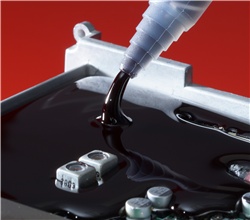Eliminate The Mixing, Keep The Properties
If you struggle with the time and cost of mixing separate adhesive components, one-component epoxies can make your life a lot easier. Yet many one-part epoxies trade off some physical properties for ease of use. That’s not the case with our 50–3122 One-Component Epoxy.
Even though it requires no mixing, 50–3122 does not skimp on strength, thermal, electrical and other important properties. Here’s a closer look at what this unique one-component epoxy offers:
- Strength across a wide temperature range. With a tensile strength of 9,500 psi, a lap shear strength of 2,500 psi and a t-peel strength of 30 pli, 50–3122 creates exceptionally strong bonds. And it maintains its strength over a wide temperature range of –60 to 205°C, making it a good choice for structural bonding applications subject to temperature extremes.
- Impact and vibration tolerance. 50–3122 also has a high tensile modulus of 675,000 psi, which helps it withstand heavy impact loads, vibration and thermal shocks.
- Thermal and electrical insulation. 50–3122 is more than strong. It also acts as both a thermal and electrical insulator with a thermal conductivity of 1.44 W/m•K and a dielectric strength of 370 Volts/mil. These insulating properties come into play in many electrical, aerospace, appliance, automotive and industrial bonding applications.
- Chemical resistance and low outgassing. Epoxies in general offer great chemical resistance, and 50–3122 is no exception. As a solvent-free formulation, 50–3122 also meets NASA outgassing standards (ASTM E595–07).
As with any one-part epoxy formulation, 50–3122 requires heat curing. To learn more about the recommended cure schedule and other technical specifications, download our 50–3122 Technical Bulletin.





 Epoxy adhesives, sealants and potting compounds must meet certain requirements in order to be considered for use within or as a part of a medical device. In addition to important cured properties such as hardness, temperature and chemical resistance, tensile strength and electrical insulation properties; the epoxy must also meet certain biocompatibility requirements.
Epoxy adhesives, sealants and potting compounds must meet certain requirements in order to be considered for use within or as a part of a medical device. In addition to important cured properties such as hardness, temperature and chemical resistance, tensile strength and electrical insulation properties; the epoxy must also meet certain biocompatibility requirements. An Optical and Semiconductor Grade Epoxy Resin system has been developed for LED encapsulating, glob top encapsulation, fiber optics and as an underfill for flip chips. The
An Optical and Semiconductor Grade Epoxy Resin system has been developed for LED encapsulating, glob top encapsulation, fiber optics and as an underfill for flip chips. The  Epoxies, Etc. has developed a fast curing thin film
Epoxies, Etc. has developed a fast curing thin film Lightweight (syntactic) potting compounds have been used for years in electronics due to their exceptional strength, stiffness, dimensional stability, buoyancy and water resistance. They feature low dielectric constant, low shrinkage on cure, low moisture absorption, outstanding thermal and mechanical shock resistance and weight savings. Similar chemistries have also been used in the manufacture of flotation devices and aerospace composites.
Lightweight (syntactic) potting compounds have been used for years in electronics due to their exceptional strength, stiffness, dimensional stability, buoyancy and water resistance. They feature low dielectric constant, low shrinkage on cure, low moisture absorption, outstanding thermal and mechanical shock resistance and weight savings. Similar chemistries have also been used in the manufacture of flotation devices and aerospace composites. Mixing and proportioning of two component epoxy systems is time consuming and prone to processing errors. The
Mixing and proportioning of two component epoxy systems is time consuming and prone to processing errors. The 